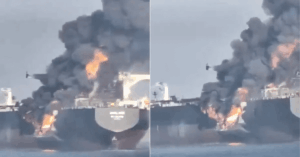
India Plans To Cut Fuel Exports, Reroute Oil Imports If Strait of Hormuz Is Blocked
June 20, 2025
CMA CGM Osiris Becomes First Large Ship To Transit Suez Canal After Long Halt
June 20, 2025

Satellite images have revealed a massive oil slick stretching across approximately 1,500 hectares in the Gulf of Oman after a collision between two large oil tankers near the Strait of Hormuz.
The incident occurred early Tuesday, June 17, about 22 to 24 nautical miles off the coast of the UAE near Khor Fakkan. The vessels involved were the crude oil tankers Adalynn and Front Eagle.
The UAE Ministry of Energy confirmed minor structural damage to both ships and a fire aboard one of them, which was quickly extinguished. No injuries were reported.
Despite the official statements downplaying the severity, Greenpeace Middle East and North Africa (MENA) has warned of a potential environmental disaster.
The organisation cited satellite imagery and data from Planet Labs, Lloyd’s List Intelligence, and Veson Nautical to suggest that the 23-year-old Adalynn may have been carrying around 70,000 tons of crude oil, even though it was officially listed in ballast condition.
The vessel is reportedly part of a Russian “shadow fleet,” known for using outdated ships that often operate below standard safety protocols.
‘Dark fleet’ tanker MV Adalynn (165,000-dwt) on fire after being struck by another tanker MV Front Eagle (300,000-dwt ) just south of Strait of Hormuz in early hours of this morning.
All 24 crew of Adalynn safely evacuated. No casualties on Front Eagle.
Believed to be caused by… pic.twitter.com/shylx7cfHE
— Navy Lookout (@NavyLookout) June 17, 2025
Greenpeace MENA urged authorities to act swiftly to contain the spill and assess the environmental impact. The group emphasised that incidents like this threaten marine ecosystems, disrupt food chains, and highlight the urgent need for maritime monitoring and transparent reporting by governments and oil companies.
According to maritime analytics firm Windward, the Front Eagle experienced prolonged GPS and AIS jamming before the collision. The company said this points to a growing maritime security threat in the region.
Windward reported that nearly 970 ships per day in the Arabian Gulf and Strait of Hormuz had been affected by navigation interference over the past four days.
The UAE Ministry blamed the collision on “navigational misjudgment,” but growing regional tensions are also under scrutiny. The crash happened just days after Israeli airstrikes on Iran, raising fears of disruptions to oil transport in the area.
The Strait of Hormuz is a critical global oil route, with about 20 million barrels of oil, nearly one-fifth of global consumption, passing through it daily, according to the U.S. Energy Information Administration.
Officials from the Russian consulate in Dubai confirmed that the crew of Adalynn, including seven Russian nationals, was safely relocated to a hotel in Fujairah.
Frontline, the company that owns Front Eagle, has since stated it will avoid taking new contracts that involve transiting through the Strait of Hormuz. Speaking at a maritime finance conference in New York, the company’s CEO called the encounter with a dark fleet tanker “challenging” but added that a more severe disaster was avoided.
Greenpeace stressed that accidents like this highlight the need to shift from fossil fuels to renewable energy for a safer environment and stronger global security.
Reference: Greenpeace
Source: Maritime Shipping News


